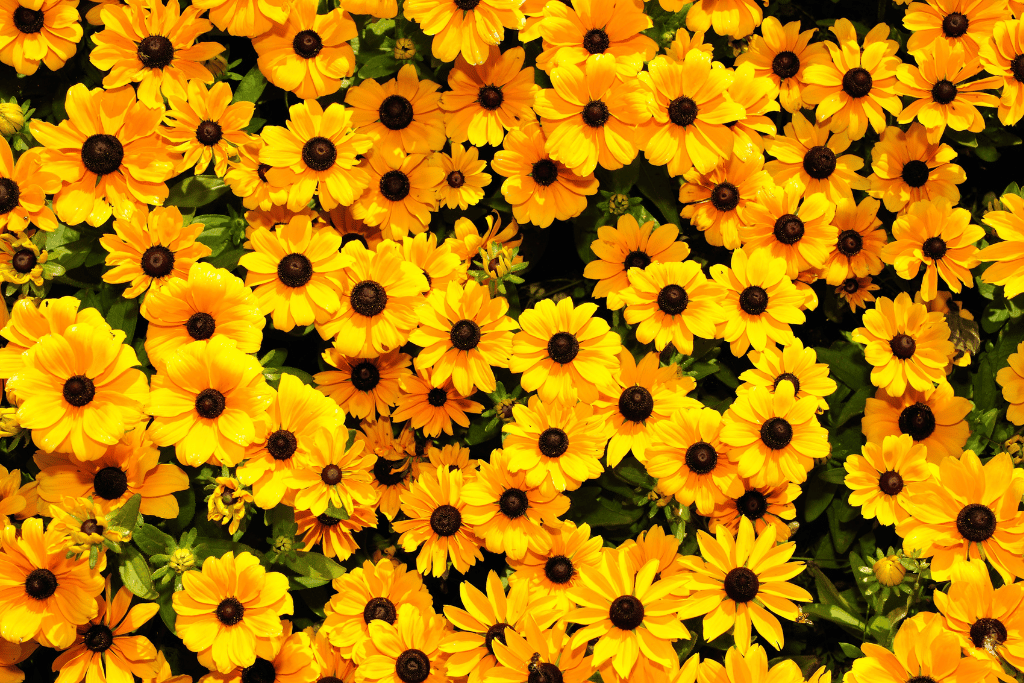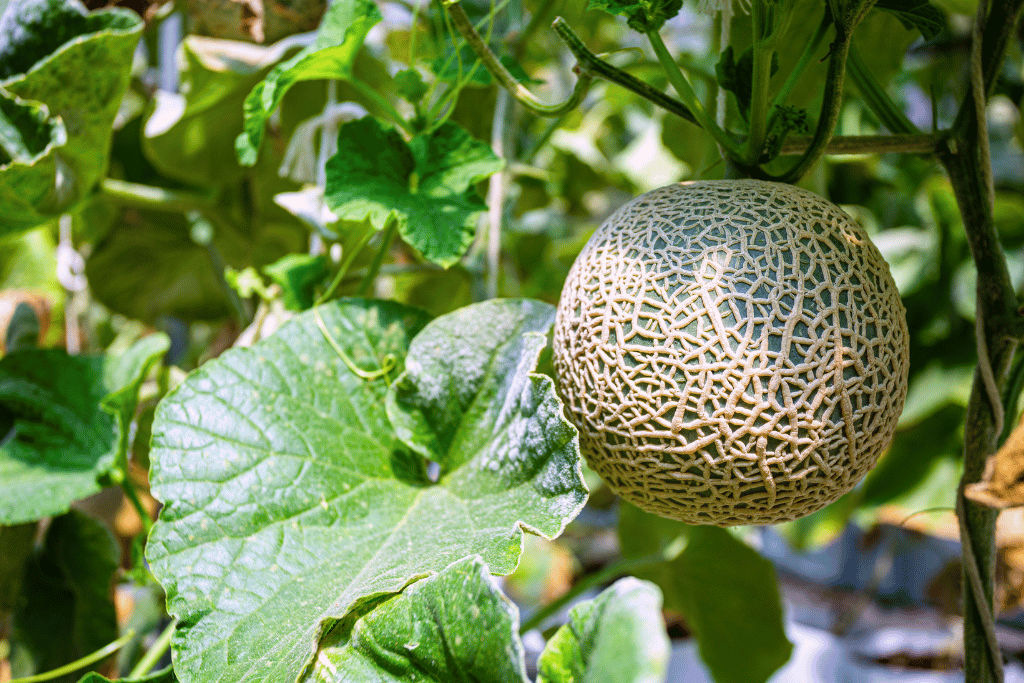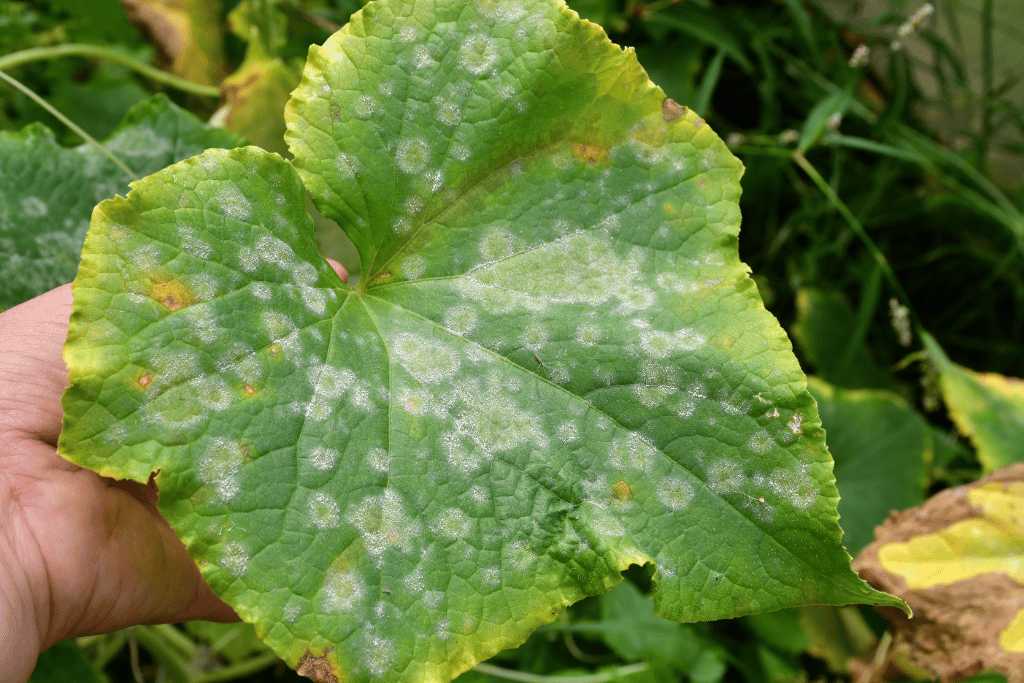
If you’re an avid gardener, you may have noticed white spots on cucumber leaves. Don’t worry, you’re not alone! These pesky patches tend to appear on this healthy vegetable and intimidate even advanced horticulturists, but with the appropriate methods, you can keep your greens flourishing. Let’s dive into the most probable cause of this issue along with all the potential preventative measures and treatments you can take to provide your cucumbers a long and happy life!
About Cucumber Plants In General

Cucumbers (Cucumis sativus) are members of the Cucurbitaceae family, and hail from the tropical regions of South Asia but have since spread their vines across the world.
This plant is a sprawling vine with big, green leaves and delicate yellow flowers that attract pollinators. Its elongated, cylindrical fruit is the star of the show, with bright green skin that’s slightly bumpy to the touch. When you slice into it, you’ll reveal a cool and crisp flesh that’s perfect for salads, pickling, or even as a refreshing snack on its own.
Cucumbers come in various sizes, ranging from the petite gherkin to the longer English cucumber, but all share that signature refreshing crunch. So, whether you’re looking to add an extra healthy ingredient to your salads or elevate your gin and tonic game, the cucumber plant is one versatile vegetable that won’t disappoint.
Most Common Cucumber Plant Problems

This popular greenery is susceptible to a variety of pests, ranging from insects to mites. The most frequently occurring types of pests that may infest your greens are cucumber beetles, spider mites, aphids, and thrips. Cucumber beetles chew on the leaves, stems, and fruits, causing extensive damage, while spider mites and aphids suck sap from the leaves, leading to wilting and yellowing. The presence of thrips leads to leaf deformation, discoloration, and scarring.
Apart from critters, cucumber plants are also prone to numerous diseases that potentially reduce yield and produce quality. One of the most common conditions is bacterial wilt, which makes its victims wither and die rapidly. Another potential disease is downy mildew, which brings about yellow spots on the upper surface of the leaves, and a white, fluffy growth on the underside. Fusarium wilt and anthracnose are other issues to reckon with, causing discoloration, stunted growth, and fruit rot.
But what causes white spots on cucumber leaves? Well, powdery mildew is the answer to that question. It’s one of the primary health deteriorating conditions attacking cucumber plants, responsible for an array of diverse symptoms. So, let’s put this vile culprit under the microscope to see how to eradicate or even prevent it!
What Is Powdery Mildew?
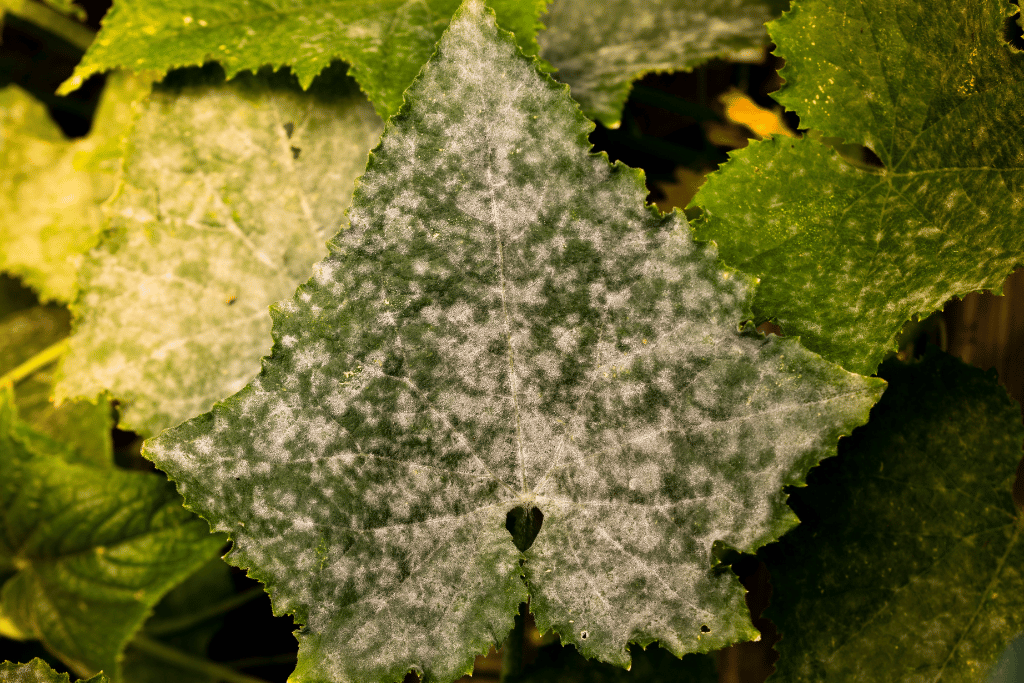
Powdery mildew is a common fungal disease that affects cucumber plants, as well as other greenery in the cucurbit family. It is characterized by a white or gray powdery coating that appears on the leaves, stems, and fruit of the plant. The powdery substance is actually a mass of fungal spores that can quickly spread from plant to plant, leading to halted growth and reduced yields.
The occurrence of white spots on cucumber leaves because of powdery mildew are varied and may include factors such as high humidity, poor air circulation, and warm temperatures. Additionally, over-fertilization or imbalanced soil pH levels might further weaken greens and make them more susceptible to infection. While this disease can be difficult to prevent, gardeners should still take steps such as practicing good sanitation habits and selecting disease-resistant plant varieties to help reduce the risk of infestation.
In general, it is significant to keep a watchful eye for the appearance of powdery mildew on cucumber plants, as early detection and treatment contribute greatly towards preventing the disease from spreading and causing major damage to the crop.
How To Prevent White Spots On Cucumber Leaves
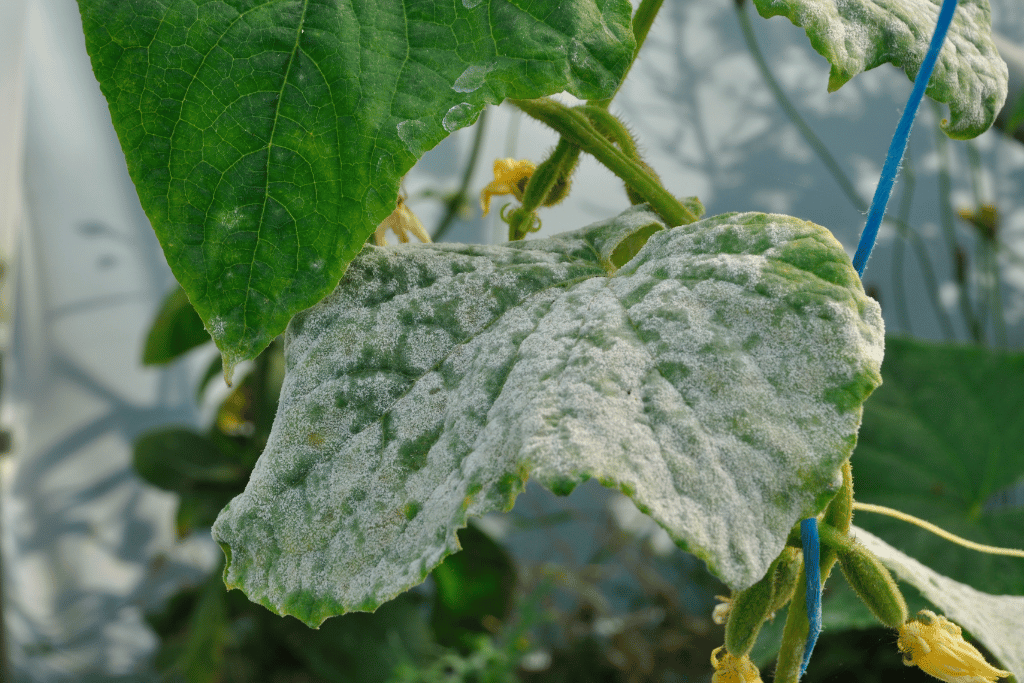
In case your greenery is lucky enough not to have been overrun by powdery mildew, let’s keep it that way! Below you can discover how to pivot the care you provide your greens in a way to keep them far away from this unpleasant condition.
Sunlight exposure
Powdery mildew thrives in shaded areas and moist environments, making cucumber plants a prime target. Providing your leafy friends with at least 6 hours of sun exposure each day is crucial in avoiding the disease to take hold. If your plants are not getting enough sunlight, consider moving them to a sunnier location or trimming nearby trees or shrubs that are blocking natural light.
Watering
Overhead watering potentially creates a humid environment that promotes the growth of white spots on cucumber leaves. Hydrating at the base of the plant is a better option as it minimizes the moisture on the leaves. Moreover, it is crucial to water early in the day to allow time for the plants to dry before nightfall. Additionally, avoid watering during periods of high humidity or wet weather, as this can create a breeding ground for fungal spores.
Soil requirements
Choosing the right soil is another critical factor in preventing white spots on cucumber leaves. These greens need well-draining soil that is rich in organic matter. The organic matter helps to promote beneficial microbes that generate a shield against fungal infections. Avoid over-fertilizing with nitrogen, which runs the risk of advancing lush foliage that is more susceptible to powdery mildew. Instead, opt for a balanced fertilizer with higher potassium content, which strengthens the plant’s cell walls and improves its resistance to fungi.
Humidity
Powdery mildew thrives in humid conditions, making good airflow and proper spacing critical in preventing the condition. Avoid crowding cucumber plants, which makes the surroundings more humid and thus creates a hotbed for the growth of fungal spores. Additionally, prune dead or diseased foliage promptly and thin out the plants when they start to get crowded. Plus, provide appropriate airflow by spacing the plants adequately and avoiding cramming them in areas with poor ventilation.
Temperature
Finally, be mindful of the temperature, as powdery mildew tends to develop in warm conditions ranging from 60-80°F (16-27°C). Try to keep your cucumber plants in an environment that does not exceed this range. Furthermore, monitor the temperature and humidity levels regularly, and take appropriate action if conditions become favorable for the disease to thrive. By following these specific preventative measures, you can ensure that your greenery remains healthy and free from infections.
Spacing
Proper spacing can break or make the occurrence of fungal diseases. Placing your flora too closely to one another boosts the water content of the air significantly. To circumvent this issue, sow seedlings at least 12-18 inches (30-45 cm) apart in rows spaced 5-6 feet (about 1.5-1.8 meters) apart. This will encourage suitable airflow and help to prevent the spread of disease.
How To Get Rid Of White Spots On Cucumber Leaves

The damage is already done? Fear not – this doesn’t mean you need to discharge all your infested specimens. Instead, ready your weapons and prepare to fight this adverse troublemaker! In return for your efforts, you’ll be rewarded with healthy and flourishing plants!
Organic Treatments
- Neem oil: Neem oil is an organic insecticide and fungicide usually used to control powdery mildew. Mix 2 tablespoons of neem oil with a gallon of water and spray the solution onto the affected area once a week.
- Baking soda: Baking soda is another natural fungicide that’s effective against fungi. Create a mixture of 1 tablespoon of baking soda and a quart of water and spray it onto the infested greens every 7 to 10 days.
- Milk: Milk contains a protein called casein that may help keep powdery mildew at bay. Mix 1 part milk with 2 parts water and spritz the plants with it every 10 to 14 days.
- Potassium bicarbonate: Potassium bicarbonate is an organic fungicide suitable to control the disease in question. Add 2 tablespoons of potassium bicarbonate to a gallon of water and use it on your greenery every 7 to 10 days.
- Sulfur: One of the most commonly used fungicides for targeting white spots on cucumber leaves is sulfur. It’s available in both dust and liquid formulations and can be found at most garden centers or online stores. Apply the formula once every week, or as advised on the product label. Sulfur works by creating an environment that is unfavorable for fungi to grow.
- Garlic spray: Garlic has natural antifungal properties that might be just what you need in your battle against powdery mildew. Crush 3 to 4 cloves and mix them with 1 quart of water. Allow the mixture to sit for a few hours, strain out the garlic, and spritz the liquid onto the targeted area. Use it once per week for optimal results.
- Prune infected leaves: If nothing else works, it is best to remove the sick leaves altogether and dispose of them. This will prevent the disease from spreading to other parts of the plant.
Choose Disease Resistant Cucumber Varieties
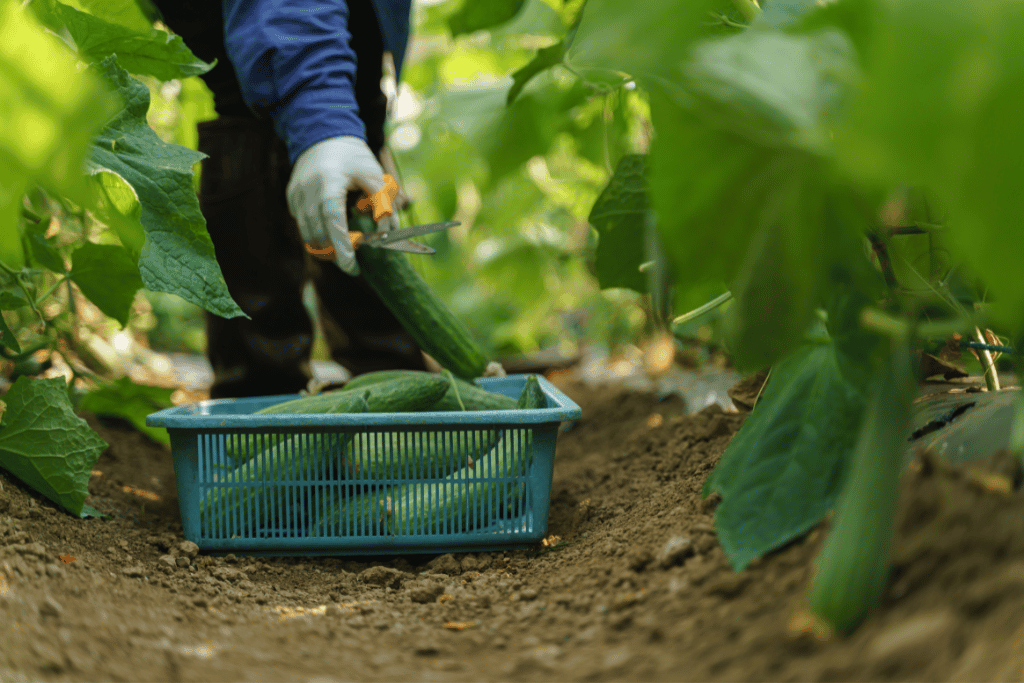
One thing is to know how to treat white spots on cucumber leaves, and another one is to opt for cucumbers that repel powdery mildew in the first place. Powdery mildew resistant cucumber varieties are a boon for gardeners who want to grow healthy and fruitful produce without the hassle of dealing with this common problem. These varieties are usually labeled as “PM” “PMR” or “powdery mildew resistant” in nurseries and garden centers.
PMR cucumbers are different from other varieties in that they have been specifically bred to resist this type of fungus, meaning they are less susceptible to it and can produce fruit even in humid conditions. They typically have a bushier growth habit than other cucumber varieties, which makes them suitable for container gardening and smaller spaces.
When choosing these specific products, look for varieties such as ‘Marketmore 76 PMR’, ‘Saladin PMR’, or ‘Dasher II PMR’. These have been tested and proven to resist powdery mildew, ensuring a healthy crop.
Final Thoughts
At the beginning of this all-encompassing guide, you wondered “Why are there white spots on my cucumbers’ leaves?”. Well, I hope I could provide you with exact answers to your worries. Don’t be disheartened by the white patches, as they could happen even under the watch of seasoned gardeners. The key is early identification and effective action, which will give back your precious green garden in no time!
Frequently Asked Questions (FAQ)
Does soapy water get rid of powdery mildew?
While soapy water can help control powdery mildew, it may not be as effective as other treatments. It’s best to use a combination of prevention methods and targeted treatments for powdery mildew, such as neem oil or baking soda with water.
Can plants recover from powdery mildew?
Yes, as we’re talking about a moderate disease, plants can recover from it with proper treatment. Early detection and intervention, proper sanitation practices, and targeted treatments contribute to keeping the fungus under control.
Can cucumber leaves infected with powdery mildew be composted?
It is generally recommended to avoid composting plant material that is infected with powdery mildew. While the fungus can be killed during the composting process, it’s better to dispose of the affected plant material in the trash to prevent the spread of the disease.


